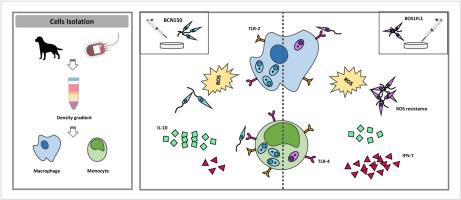Veterinary Immunology and Immunopathology ( IF 1.8 ) Pub Date : 2020-11-07 , DOI: 10.1016/j.vetimm.2020.110148 Alicia Mas 1 , Abel Martínez-Rodrigo 1 , Jose Antonio Orden 1 , Luis Miguel Viñals 2 , Gustavo Domínguez-Bernal 1 , Javier Carrión 1

|
Human leishmaniosis caused by Leishmania infantum is a zoonotic disease, with dogs as the main reservoir in Mediterranean Basin countries. The largest European outbreak of human leishmaniosis declared in the southwestern Madrid region (Spain) is characterized by unusual epidemiological and clinical features, such as the emergence of new wild reservoirs (hares and rabbits), whereas the seroprevalence, infection, and severity of canine leishmaniosis have not substantially changed since the first studies conducted in Madrid before the outbreak. Previous studies reported that L. infantum isolates from the Madrid leishmaniosis focus displayed elevated virulence in in vivo models of infection and increased infectivity in murine target cells. With the aim of studying whether changes in the host-parasite interaction and virulence profile have developed, we first assessed the behaviour of one circulating isolate of the outbreak, IPER/ES/2012/BOS1FL1 (BOS1FL1), compared to that of a well-characterized strain from canine leishmaniosis, MCAN/ES/1996/BCN150 (BCN150), in terms of infection capacity (percentage of infected cells, representing infectivity, and number of amastigotes per infected cell, representing the intensity of infection) in canine monocytes and macrophages. BCN150 displayed significantly higher infectivity (76.82 ± 4.40 vs 38.58 ± 2.19; P < 0.0001) and intensity of infection (3.64 ± 0.13 vs 1.83 ± 0.12; P < 0.0001) than BOS1FL1 when interacting with canine cells. Our ROS induction results did not differ significantly between the two isolates or with the responses previously described for other L. infantum isolates. Paradoxically, increased resilience to hydrogen peroxide exposure was observed for BOS1FL1 (% viability 40.62 ± 5.54 vs 26.37 ± 2.93; P = 0.039). Finally, we demonstrated that a decreased intracellular load of BOS1FL1 was associated with increased IFN-γ (261.21 ± 26.29 vs 69.80 ± 9.02; P = 0.0151) and decreased IL-10 production (165.06 ± 23.87 vs 264.41 ± 30.58; P = 0.0002). In this study, we provide the first detailed insight into the differences between the isolate BOS1FL1 from the outbreak in Madrid and the well-characterized strain BCN150 MON-1 obtained from a dog in their response to interacting with canine cells. However, further studies are necessary to shed light on the immune mechanisms resulting in BOS1FL1 exhibiting less virulent behaviour in canine cells than in cells derived from other host species.
中文翻译:

马德里(西班牙)利什曼病暴发的进一步调查:婴儿利什曼原虫BOS1FL1分离株的低感染性表型在犬细胞中建立感染
由婴儿利什曼原虫引起的人类利什曼病是一种人畜共患病,在地中海盆地国家中,狗是主要的水库。欧洲西南部马德里地区(西班牙)宣布的最大的人类利什曼病暴发的特征是不寻常的流行病学和临床特征,例如新的野生水库(野兔和兔子)的出现,而犬利什曼病的血清流行,感染和严重性自疫情爆发前在马德里进行的首次研究以来,情况没有太大变化。先前的研究报道,从马德里利什曼病集中的婴儿乳杆菌分离株显示出体内的高毒力鼠靶细胞的感染和感染性增加的模型。为了研究宿主-寄生虫相互作用和毒力谱是否已发生变化,我们首先评估了一次疫情的循环分离株IPER / ES / 2012 / BOS1FL1(BOS1FL1)的行为,来自犬利什曼病的特征菌株,MCAN / ES / 1996 / BCN150(BCN150),在犬单核细胞和巨噬细胞中的感染能力(感染细胞的百分比,代表感染性,每个感染细胞的变形虫数量,代表感染强度) 。BCN150表现出明显更高的传染性(76.82±4.40 vs 38.58±2.19; P <0.0001)和感染强度(3.64±0.13 vs 1.83±0.12; 与犬细胞相互作用时,BOS1FL1比P <0.0001)。我们的ROS诱导结果在两个分离株之间或与先前针对其他婴儿乳杆菌分离株描述的反应没有显着差异。矛盾的是,观察到BOS1FL1对过氧化氢暴露的抵抗力增强(%生存力40.62±5.54对26.37±2.93;P = 0.039)。最后,我们证明BOS1FL1的细胞内负荷降低与IFN-γ升高有关(261.21±26.29 vs 69.80±9.02;P = 0.0151)和IL-10产生降低(165.06±23.87 vs 264.41±30.58; P= 0.0002)。在这项研究中,我们提供了第一个详细的见解,以了解马德里爆发的BOS1FL1分离株与从狗中获得的特征明确的BCN150 MON-1菌株在与犬细胞相互作用中的反应之间的差异。但是,有必要进行进一步的研究以阐明免疫机制,从而使BOS1FL1在犬类细胞中表现出比从其他宿主物种衍生的细胞更小的毒力行为。


























 京公网安备 11010802027423号
京公网安备 11010802027423号